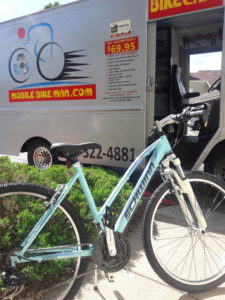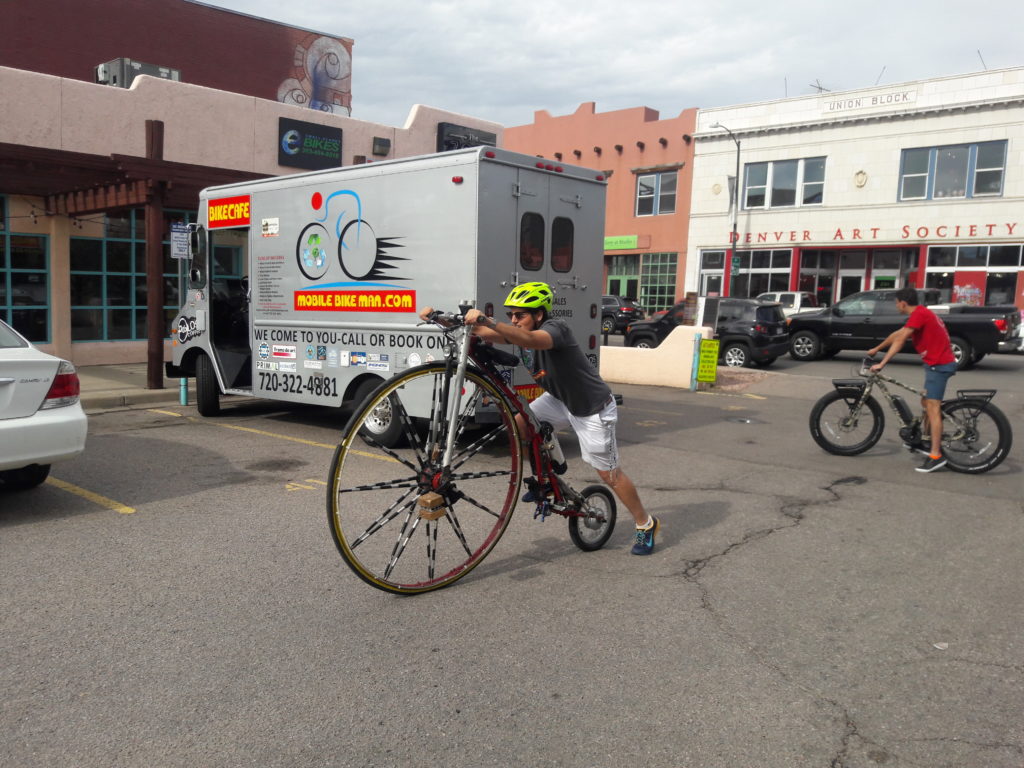Mobilebikeman.com provides eBike service. We are the only mobile bike shop in Colorado that is certified to work on on eBikes.

Battery upgrade on an eBike
An eBike is often much heavier than a standard bicycle. It can be a bit of a chore to load up a bike with a motor and battery roundtrip. Instead of hefting it yourself, contact Mobilebikeman.com. We come to you and take care of all the heavy lifting.
Before Mobilebikeman was Mobilebikeman, he was an expert auto mechanic. He rebuilt cars and knows the process inside and out. In fact, he built the Mobilebikeman vans himself. This knowledge translates well to bicycles that have a motor. At Mobilebikeman.com, we have the experience and knowledge to work on your eBike. Thus, you can have a safe and happy ride.
eBike – how does it work?
From Wikipedia:
An electric bicycle, also known as an e-bike, powerbike or booster bike, is a bicycle with an integrated electric motor which can be used for propulsion. Many kinds of e-bikes are available worldwide, from e-bikes that only have a small motor to assist the rider’s pedal-power (i.e., pedelecs) to somewhat more powerful e-bikes which tend closer to moped-style functionality: all, however, retain the ability to be pedalled by the rider and are therefore not electric motorcycles. E-bikes use rechargeable batteries and the lighter varieties can travel up to 25 to 32 km/h (16 to 20 mph), depending on the laws of the country in which they are sold, while the more high-powered varieties can often do in excess of 45 km/h (28 mph). In some markets, such as Germany, they are gaining in popularity and taking some market share away from conventional bicycles, while in others, such as China, they are replacing fossil fuel-powered mopeds and small motorcycles.
Depending on local laws, many e-bikes (e.g., pedelecs) are legally classified as bicycles rather than mopeds or motorcycles, so they are not subject to the more stringent laws regarding their certification and operation, unlike the more powerful two-wheelers which are often classed as electric motorcycles. E-bikes can also be defined separately and treated as a specific vehicle type in many areas of legal jurisdiction.
E-bikes are the electric motor-powered versions of motorized bicycles, which have been around since the late 19th century.
Perhaps you first saw an e-bike in your neighborhood, or on a local trail. Or perhaps, even speeding past you as rallied up a hill. Did you know that e-bikes have been around since the late 19th century?
From Wikipedia:
eBike- a brief History

E-bike 1932 (by Philips & Simplex)
In the 1890s, electric bicycles were documented within various U.S. patents. For example, on 31 December 1895, Ogden Bolton Jr. was granted U.S. Patent 552,271for a battery-powered bicycle with “6-pole brush-and-commutator direct current (DC) hub motor mounted in the rear wheel.” There were no gears and the motor could draw up to 100 amperes (A) from a 10-volt battery.
Two years later, in 1897, Hosea W. Libbey of Boston invented an electric bicycle (U.S. Patent 596,272) that was propelled by a “double electric motor”. The motor was designed within the hub of the crankset axle. This model was later re-invented and imitated in the late 1990s by Giant Lafree e-bikes.

A bike equipped with an after market electric hub motor conversion kit, with the battery pack placed on the rear carrier rack
By 1898 a rear-wheel drive electric bicycle, which used a driving belt along the outside edge of the wheel, was patented by Mathew J. Steffens. Also, the 1899 U.S. Patent 627,066 by John Schnepf depicted a rear-wheel friction “roller-wheel” style drive electric bicycle. Schnepf’s invention was later re-examined and expanded in 1969 by G.A. Wood Jr. with his U.S. Patent 3,431,994. Wood’s device used 4 fractional horsepower motors; connected through a series of gears.
Torque sensors and power controls were developed in the late 1990s. For example, Takada Yutky of Japan filed a patent in 1997 for such a device. In 1992 Vector Services Limited offered and sold an e-bike dubbed Zike. The bicycle included NiCd batteries that were built into a frame member and included an 850 g permanent-magnet motor. Despite the Zike, in 1992 hardly any commercial e-bikes were available.
Production grew from 1993 to 2004 by an estimated 35%. By contrast, according to Gardner, in 1995 regular bicycle production decreased from its peak 107 million units.
Some of the less expensive e-bikes used bulky lead acid batteries, whereas newer models generally used NiMH, NiCd, and/or Li-ion batteries, which offered lighter, denser capacity batteries. Performance varies; however, in general there is an increase in range and speed with the latter battery types.
By 2001 the terms e-bike, power bike, “pedelec“, pedal-assisted, and power-assisted bicycle were commonly used to refer to e-bikes. The terms “electric motorbike” or “e-motorbike” refer to more powerful models that attain up to 80 km/h (50 mph).
In a parallel hybrid motorized bicycle, such as the aforementioned 1897 invention by Hosea W. Libbey, human and motor inputs are mechanically coupled either in the bottom bracket, the rear wheel, or the front wheel, whereas in a (mechanical) series hybrid cycle, the human and motor inputs are coupled through differential gearing. In an (electronic) series hybrid cycle, human power is converted into electricity and is fed directly into the motor and mostly additional electricity is supplied from a battery.
By 2007 e-bikes were thought to make up 10 to 20 percent of all two-wheeled vehicles on the streets of many major Chinese cities. A typical unit requires 8 hours to charge the battery, which provides the range of 25 to 30 miles (40 to 48 km), at the speed of around 20 km/h.
eBike Maintenance Guide
(from www.e-bikeshop.co.uk)
To get the longest life possible out of your e-Bike you can take some simple steps to maintain it yourself. Here are some general cycle tips:
– Keep your eBike clean. If possible clean it after each ride with bike specific cleaners.
– Don’t use a jet wash or alike as this can drive out grease lubricating the bearings, it will also compress water into the internals which in turn will corrode essential components.
– If using a high powered hose be careful to not jet water in too close to the hubs, bottom bracket, headset or anywhere else that is normally greased throughout.
– Some bike shine products can leave a layer of protection over the paintwork, helping keep your eBike looking like new for longer. Be careful not to get this stuff close to any braking surfaces though!
– Use a decent chain oil to keep the chain lubricated after cleaning, make sure it isn’t left dry. Wet lube in the winter and dry lube in the summer. (Wet lube stays wet, dry lube dries).
– You can lube the cables with light spray oil, preferably one that dries and leaves a PTFE layer. If using lubricant that stays wet, on your next outing dust can stick to this causing more problems and can cause cable to seize. (With PTFE it will dry but leave a lubricating layer).
– When the bike is not in use try to keep it in a dry place out of the elements.
– Keep the tyres properly inflated. This will prevent uneven tyre wear. It will also make your life easier as the bike will roll with less resistance. In turn the motor is working less and the range is extended. This can make more of a difference than you may think. (Tyre pressures are always printed on the side of your tyre).
Motor & Battery Maintenance
Most motors these days are either sealed or not serviceable, therefore if it did go wrong it would be replaced rather than repaired, so little maintenance here.
It’s the same with the batteries; however you can take steps to extend the life of your battery. For example keeping it topped up, not leaving it to discharge for extended periods of time, not leaving it in the blazing hot sun for long periods and also not leaving it out in the freezing cold for many months if it is not being used. Most battery problems I come across are where people have neglected their batteries, or have left them for years and years before coming back to them expecting them to work as they did when new!
With most modern Lithium cells it is better to keep the battery topped up. So even if you only go for a relatively short ten mile cycle down the road, it is healthier for the battery to be topped up after that ride as opposed to letting it run right out and charging it right back up.
If the battery seems to be deteriorating, the capacity can be checked by a good dedicated eBike shop. Say for example the battery gets very cold or you leave it in the shed for an extended amount of time, it can benefit from a full conditioning cycle. To do this run the battery completely flat and charge it right back up. This should condition the battery back to state. It may be worth doing it twice to be sure.
Battery packs can be made up of many cells and sometimes these cells become unbalanced. Many modern batteries keep themselves balanced correctly, with an on board BMS, (Battery Management System) however it is possible to charge the individual cells to balance them all. This should be done by a decent eBike shop correctly.
Electrical Problems, what to do?
If you do experience any electrical faults with your eBike you should contact the dealer you purchased the bike from. They should be experienced to help you.
If you are not experienced, do not take any of the electrics apart. Do not remove any plastic covers as you could damage the internals and also invalidate warranties; this should be done by an eBike technician.
If you do decide to ‘fiddle’ make sure to have a magnetic tray or some way of containing bolts etc. as bits may drop out as you open the case.
It’s always good to lay parts out in the order you removed them; this way you will have a rough idea of how it all goes back together.
Before returning to the dealer you may want to check the electrical connectors: it could be a really simple problem. Say you hit a hard bump in the road and the power cuts off, check the battery is securely in place as it may have moved slightly on the connector causing a momentary loss of connection.
You can also make sure all contacts are clean and corrosion free.
Many modern eBikes have on board diagnostics to tell the dealer what’s going on in the event of a problem. Some more simple systems are a case of subtraction, where each component is tested until the faulty component is diagnosed.
Sometimes it’s as simple as turning the eBike off and back on. Doing this will reset the controller and could get you going again.
Be wary however, that by resetting, it implies there was a problem and you should still have it checked out by an eBike technician.
Some eBikes are more reliable than others and sometimes you just get unlucky; do what you can to look after your pride and joy, and you will enjoy many years of happy eBiking.
Simply put: An eBike really shouldn’t require any more maintenance than a normal push bike, just as long as you treat it correctly.
eBike – Reasons to ride
Why ride an eBike?
Alternative transport to car – no gas $$ needed!
Helping the environment <3
Novice riders can keep up with a more seasoned rider
Older riders or riders with mobility issues can ride with more ease
Live in a hilly place
Dealing with wind
Fitness
Commuting and want to arrive less sweaty
Fun
and more!
If you need service for your eBike, remember Mobilebikeman.com provides eBike service. We come to you!
Request Service
Happy Riding 🙂







